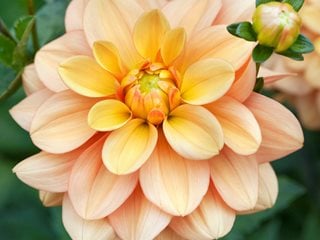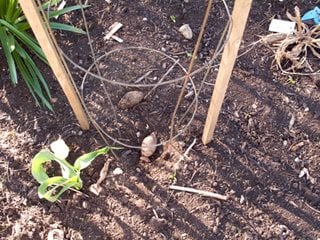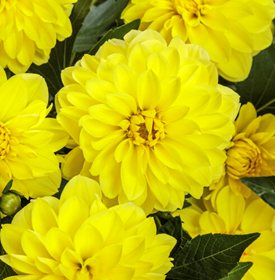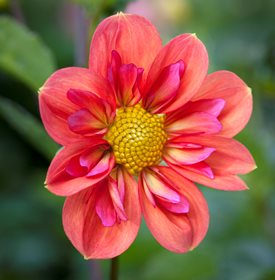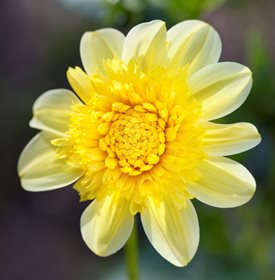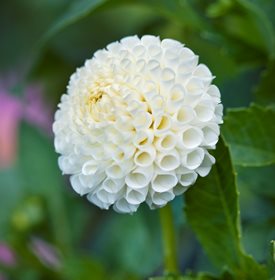How to Grow Dahlia Flowers: Planting, Care & Beautiful Varieties
Planting, care, storage, and design tips, plus top varieties for every gardenDahlias are easy to grow once established, thriving in well-drained soil and full sun. Their vibrant blooms bring late-season color from midsummer through frost. With 42 different species and thousands of cultivars, dahlias offer plenty of variety. Variations in color, flower form, size, and foliage make it easy to find one you'll love.
On this page: Dahlia Basics | Planting Tips | Care | How to Dig & Store Tubers | Varieties |FAQs | Design Ideas
On this page:
- BASICS
- PLANTING DAHLIAS
- DAHLIA CARE
- DIGGING & STORING DAHLIA TUBERS
- DAHLIA VARIETIES
- FREQUENTLY ASKED QUESTIONS
- DESIGN IDEAS
DAHLIA BASICS
Zones:
Winter hardy in zones 8-10, where tubers can stay in the ground. In colder zones, tubers can be dug up, stored for winter, and re-planted in spring after all danger of frost has passed. (See our video: How to Dig & Store Dahlias for more.)
Height/Spread:
1 to 6 feet tall, and 1 to 3 feet wide depending on the variety; border dahlias range 15 to 20 inches tall.
Exposure:
Full sun
Soil:
Well-balanced, organically rich and well-drained soil.
Color:
Varieties include shades of red, pink, lavender, purple, orange, yellow, and white
Bloom Time:
July to September
Dahlia types:
Learn more about the types of dahlias.
PLANTING DAHLIAS
According to Frances Palmer, well-known potter and dahlia enthusiast, a good planting time for tubers is May. Here are her recommendations for planting:
- Place growing cages (tomato cages work well) in the soil and drive in 2-3 stakes adjacent to them for support.
- Dig the hole, place the tubers, and gently cover with soil.
For new or single tubers: Place them in a fairly shallow hole, approx. 3 inches deep, with the new bud facing up.
For larger groups of tubers: Place in a deeper hole, keeping them approx. 3 inches below the surface. - Attach a label to the cage for identification.
- Wait to water until sprouts appear. Too much moisture early on can cause tubers to rot. If soil is very dry, a light watering is okay.
- The first leaves should poke through the surface in about 1-2 weeks.
Starting dahlias indoors:
If you live in a cold climate and want to get a head start, tubers can be started inside 6 weeks before moving them out to the garden. Plant them in pots with potting soil and provide plenty of light and water. When the ground temperature in your garden reaches 60°F it is safe to transplant your dahlias.
Planting dahlias in containers:
Low-growing or dwarf dahlias are best for growing in containers. Use a pot with drainage holes and a high-quality potting mix. Plant tubers about 2 inches deep and water lightly. Once shoots appear, water regularly to keep the soil evenly moist.
Get 7 tips for growing dahlias in pots in this video from Bethany @chicagogardener.
DAHLIA CARE
Watering:
Consistent moisture is key to healthy, productive plants. The American Dahlia Society recommends keeping soil conditions balanced for your climate and soil type: "Dahlias produce large plants and therefore need a fair amount of water. Ideally you will keep your soil evenly moist, never let it be soggy, and never let it dry out. Your soil and climate conditions will impact your ability to do this. If your soil is sandy, expect to water often. If you have clay soil, do everything you can to improve drainage and then water carefully." — Dahlia University, on watering.
Fertilizing:
Bone meal can be applied 2 to 3 times between June and October to encourage blooming. If your soil is healthy, this may not be needed at all. Apply an all-purpose fertilizer at planting to get them off to a good start.
Staking:
As your dahlias grow, gently encourage the stems to stay inside the cage for support. Garden twine can be tied around the outside for additional support.
Pinching:
When the first set of leaves is about 8 to 12 inches high, pinch out the center bud to encourage multiple stems to grow and produce more flowers. Sometimes this process is called topping.
Disbudding:
If you want longer, stronger stems and bigger flowers then you’ll need to remove the two pea-sized buds flanking the central bud. For certain types, it may be beneficial to remove more buds further down the plant. See this short disbudding video from the Portland Dahlia Society.
Deadheading:
Deadheading will keep your plants looking tidy and encourage them to continue blooming by directing the plant's energy into producing more flowers instead of seed. Many gardeners report that when they regularly deadhead their dahlias, they will bloom until the first frost. Be careful not to remove new buds, which are rounded—the spent flowers have a triangular or cone shape. Make your cut slightly higher than where the stem of the flower meets a main branch. With the spent flower removed, new buds will develop at this intersection and you’ll have more flowers in a few weeks.
Dividing:
You can divide dahlia tubers in fall after digging or in spring before planting. Many gardeners prefer spring because the eyes (growth points) are easier to see, making it simpler to separate healthy, viable tubers. Use a clean, sharp knife or pruners, and ensure each division has at least one eye and is free from damage or disease. Dividing every few years helps maintain vigorous plants and increases your stock for the garden or sharing.
Pests and Diseases:
Dahlias can be bothered by aphids, stem borers, spider mites, and caterpillars. Additionally, powdery mildew, dahlia mosaic virus, and fungal leaf spot can also cause problems.
HOW TO DIG & STORE DAHLIA TUBERS
Want to see the full process in action? In this video, Heather walks you through her step-by-step method for digging, cleaning, curing, and storing dahlia tubers for winter.
If you live in an area where you'll need to store your tubers over winter, here are some helpful instructions:
- Wait 1–2 weeks after a hard frost wilts foliage to allow energy to move into the tubers.
- Label plants before cutting stems to 6 inches.
- Dig wide around the plant to avoid damaging tubers; lift gently.
- Rinse off soil and trim off fine roots, damaged or diseased tubers.
- Let tubers cure for 48 hours in a dry, shaded spot; avoid concrete.
- Store in a breathable container with pine shavings or similar packing material.
- Lightly mist packing to retain minimal moisture; don’t oversaturate.
- Keep in a dark, cool place (35–50°F). Avoid freezing.
- Check monthly for rot or shriveling and adjust moisture as needed.
Have more questions on dahlia storage? Check out this short video: 3 Common Dahlia Storage Questions from Heather @HereSheGrows.
DAHLIA VARIETIES
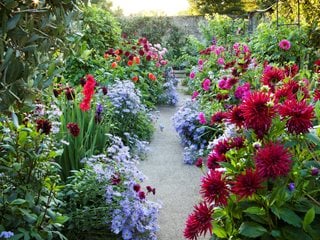
Magenta ‘Ambition’ and deep-red ‘Nuit d’Eté’ dominate this late-season border; blue Aster x frikartii ‘Mönch’ and gladioli play supporting roles. These late bloomers pick up where summer-flowering plants leave off, giving the garden a grand sendoff for winter. Photo by: Marianne Majerus.
FREQUENTLY ASKED QUESTIONS
When should I plant my dahlia tubers?
Plant dahlia tubers in spring after the danger of frost has passed and the soil has warmed to around 60°F.
Do dahlias come back every year?
Yes. In warm climates (Zones 8–10), dahlias can overwinter in the ground. In colder zones, dig and store the tubers indoors to replant next year.
Why aren't my dahlias blooming?
Possible reasons include too much nitrogen, not enough sunlight (they need full sun), or lack of deadheading. Improper watering can also affect blooming.
Are dahlias good for pollinators?
Single-flowered and collarette dahlias are best for pollinators like bees and butterflies, as their centers are more accessible.
When can I divide dahlia tubers?
You can divide in fall, but many gardeners prefer to wait until spring when eyes are more visible, making it easier to separate viable divisions.
DESIGNING WITH DAHLIAS
There are many ways to use dahlias in the garden. Here are a few tips and suggestions:
- Hide dahlias’ bare lower stems and support heavy blooms (especially dinnerplate types) by planting them among other plants or staking.
- Place tall varieties with perennials or ornamental grasses at the back or center of borders; mix shorter types with annuals or low perennials.
- Grow the smallest varieties in containers.
- Use their bold colors to echo or complement other flowers and foliage in your garden.
- Pair with late-flowering perennials for contrast; yellow dahlias with goldenrod, or purple dahlias with asters.
- Create striking contrast by pairing with fine-textured ornamental grasses.
- In formal gardens, set them against the crisp foliage of clipped hedges.
- Choose large-flowered types like dinnerplate or waterlily dahlias for cutting; they have long, sturdy stems and long-lasting blooms.
However they are used, dahlias will be in their full glory by September, and help the summer garden end on a high note.
RELATED:
20 Best Summer Bulbs to Grow
Summer Flowering Plants
Summer Arrangements: Sunflowers, Zinnias, and Dahlias
